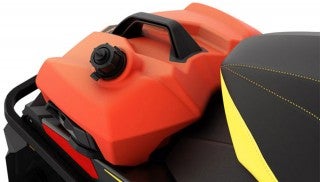How to Store Your Sled in the Off-Season

Proper care key to next year's first ride
In the summer, snowmobiles are subjected to high temperatures that cause greater rates of chemical activity on several areas of the machines, some of which can affect durability. Batteries may deteriorate, seat covers may crack and the gasoline will go stale. The purpose of storing your snowmobile properly is to try and reduce the chance of any part of it failing due to lack of use.
When storing your machine, completely clean and polish it. If a solvent is first used on greasy areas, high-pressure car washers work well. However, use caution. The water can be forced past bearing seals, which will cause them to rust. With the machine, engine and drive system clean and dry, inspect for damage, wear or cracks. Scratches and bare metal spots can be spray-painted. Ski bottoms should also be painted.
Basic Storage Preparations:
· Start the engine and pull on the oil pump cable to hold it open. This will allow a very rich mixture of oil to be injected into the engine. Its purpose is to lubricate internal engine parts (such as the piston pin and bearings) that would normally see little oil if you poured it through the spark plug hole. Make sure you run the engine for 10 to 15 minutes with the oil pump cable pulled out fully. Doing so will ensure that there is sufficient oil circulating throughout the engine.
· Completely fill the fuel tank with gasoline and add a fuel conditioner/stabilizer in proper proportions to preserve the fuel. By eliminating air space in the fuel tank, you ensure that oxidization of the fuel will be minimal and condensation cannot occur.
· Remove the carburetor float bowl drains and allow all the fuel to run out. If the fuel were to remain, the majority would evaporate, but the remainder would form a chalky residue that could block the jets and passageways. Most often when the fuel delivery is impaired, the engine fails due to the fuel/air ratio being too lean. If there is no fuel in the carburetors, problems will be minimal.
· Remove the drive belt and make sure to store it unrolled. This prevents damage to the drive belt and clutches. If the belt were left on the machine, it would set to its installed shape and not rotate properly around the clutches when the snowmobile was put into use the following season. This also prevents the chance of condensation between the belt and clutch sheaves.
· Take the battery out and put it in a safe place. Make sure it is out of the sunlight. Charge the battery once a month with a small charge that is rated at no more than 2 amp/hr. It is normal for the fluid level to go down both when the battery is in use and in storage. Add distilled water to the top of the fill line on the battery case if the level goes down, and recharge the battery.
· Block off the muffler outlet, carburetor air intake, cooling system intake and outlet holes. This will prevent small animals from building nests. Animal nesting may cause damage or impair performance.
· Reduce the tension on the track by loosening the track tensioning bolts to their limit. This prevents the track from stretching and cracking during the storage period.
· Disassemble the secondary clutch and grease the sheave bushing if required. Not all models require this. Check your manual to see if it is applicable.
· Coat all exposed metal surfaces, nuts, bolts, and fasteners with preserving oil like WD40. This will prevent them rusting. Keep the oil away from plastic and rubber parts so they don’t deteriorate.
Store the snowmobile in a dry place away from all sources of moisture and animals (birds and rodents). The machine should be loosely covered and stored on blocks. Blocks should be placed under the front bumper and rear frame. The track and skis should be suspended above the floor. Do not start the engine during the storage period, as this may remove the oil from inside the engine.
Source: Yamaha








 Your Privacy Choices
Your Privacy Choices